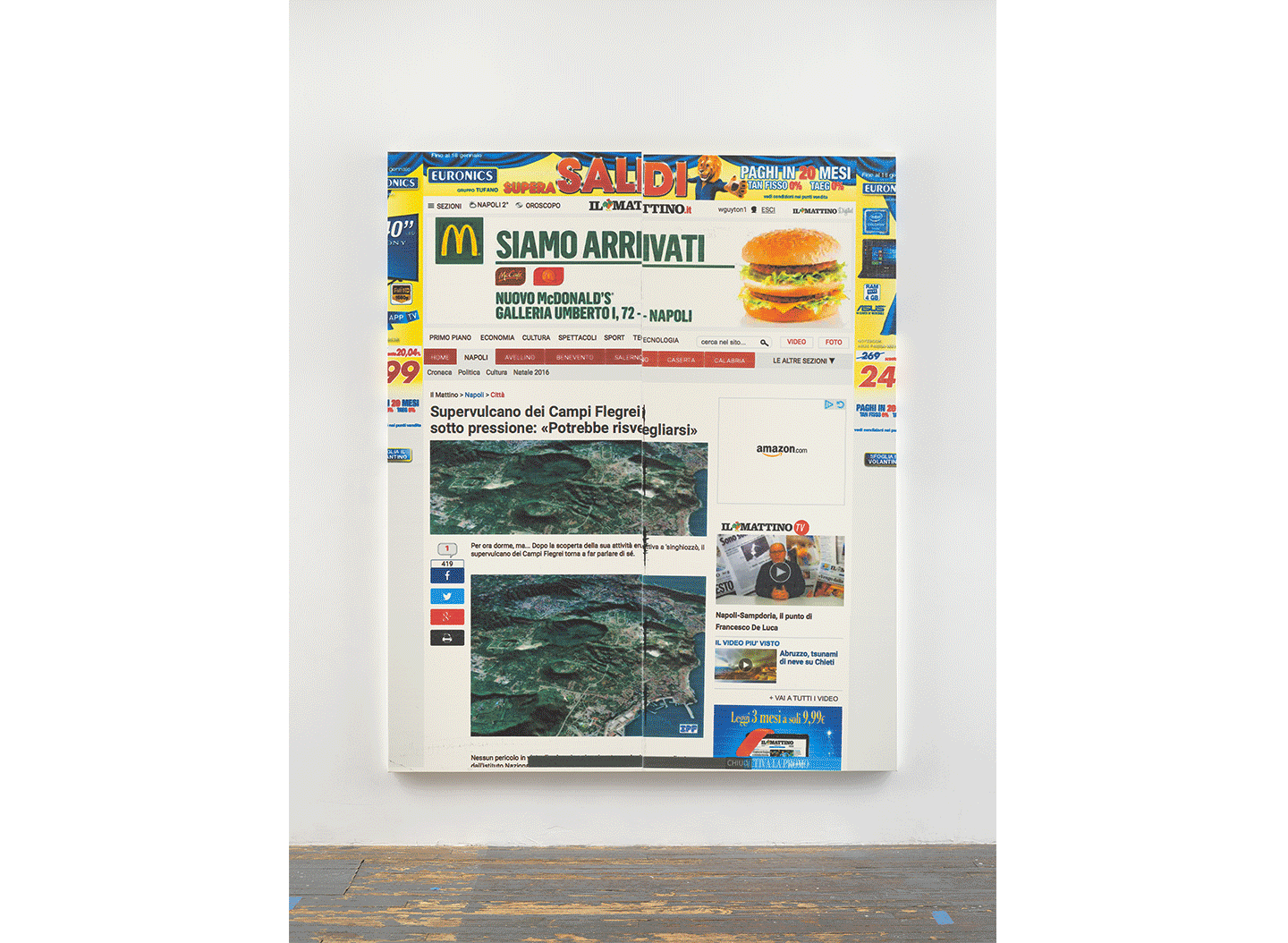Siamo Arrivati
May 15–September 11, 2017
English for Foreigners
May 15–October 16, 2017
Perla Pollina, 1996-2016
May 27–September 18, 2017
Via Settembrini, 79
80139 Naples
Italy
Hours: Wednesday–Monday 10am–7:30pm
T +39 081 1973 7254
info@madrenapoli.it
Wade Guyton
Siamo Arrivati
The Madre museum presents the first solo show in a public Italian institution of Wade Guyton (Hammond, Indiana, 1972). Since the early 2000s, Guyton’s works have explored the state and impact of the production and circulation of digital images and contents. The works conceived by Guyton during his residency in Naples are marked by the coexistence of minimal abstract forms and new figurative motifs that coincide with the deterioration of initially photographic images generated like bitmap files, which have lost their original legibility and logical structure. These works are based on the acquisition—using mobile phones, digital cameras, screenshots, scanners and software programs—of instantaneous images or reproductions from printed materials. Produced in almost real time while the exhibition was being mounted, Guyton’s works express the potential and contradictions of contemporary visual languages—in which abstraction and representation, daily chronicle and suspension of time, identity and reproducibility, singularity and multiplicity overlap. As embryonic and hybrid icons and palimpsests of the contemporary digital episteme, these works document the expansion and diversification of the ways in which digital communication shapes our knowledge of reality, like the statutes of reality itself. At the Madre, Guyton transforms as well the solidity and the authority of the museum space into a welcoming place of daily work, a malleable and rewritable architectural loop. Interconnected with the museum architecture, the exhibition display temporarily replaces the artist’s studio in New York. In this way, the residency of the artist and his team in Naples becomes the conceptual blueprint of a (self-) analytical space-time framework, which reinterprets both the classic art-historical theme of the “studio” and the tradition of the Grand Tour. This also could explain the self-ironic and plural title of the exhibition, Siamo Arrivati (“We’ve Arrived”), taken from the slogan used by McDonald’s to announce the recent opening of its restaurants in Naples.
Stephen Prina
English for Foreigners
English for Foreigners is the first solo exhibition in an Italian public institution of Stephen Prina (Galesburg, Illinois, 1954). His research—which involves visual elements, sound pieces and performative acts—explores the legacy of the conceptual artistic practices, analyzing their historical matrices as well as their possible transformations. At the Madre the artist goes back in time to relive the journey that led his father to travel from Fascist Italy to the United States: “Peter (Pietro) Prina, my father, played clarinet for the local band in the Comune di Canischio, in the Piedmont region of Northwestern Italy. One day the Black Shirts arrived and demanded that the band perform the anthem of the Italian National Fascist Party. This event convinced him it was time to emigrate from Italy—immigrate to America—at the age of 17, in 1923.”
Second Book in English for Foreigners in Evening Schools by Frederick Houghton (American Book Company, 1917), the book used by the artist’s father to learn English in his new country, became the starting point for this exhibition. Following the gradual acquisition of a new public identity by his father, Prina provides a possible critical engagement with the permeability of the seemingly dichotomous models of “ideal citizenship” that have marked the history of the 20th Century. Prina develops a journey through time, which is structured like an analysis of collective history and, at the same time, like a story of a family and of the relationship between a father and a son. Following the steps of authors as Cesare Pavese and Danièle Huillet and Jean-Marie Straub, through their examination of the intricate ties between sedentariness and migration, the affirmation of identity and its uprooting, monumentality and intimacy, Prina’s project articulates multiple references developing an analysis of the dynamics of memorials and of the relations between personal and collective sphere, between stories and history.
Roberto Cuoghi
Perla Pollina, 1996-2016
The Madre museum is the only Italian venue of the first mid-career retrospective devoted to Roberto Cuoghi (Modena, 1973). Cuoghi’s artistic practice brings together the sculptural and compositional qualities of the visual arts and the scenic-narrative qualities of a performer and storyteller. His works use partly unconventional techniques and materials, which the artist often experiments with and even re-invents, exploring the notions of simulacrum and symbol, memory and immanence, devotion and superstition, transformation and metamorphosis. The references to antiquity and the history of humanity, based on rigorous philological and documentary research, are also remolded by the artist with highly idiosyncratic results, in which temporal, spatial and epistemic planes merge together. The exhibition includes about 70 works which span the 20 years of the artist’s career, documenting and analyzing its various aspects. Right from its nonsensical title (generated by the erroneous effects of an auto-correct program), PERLA POLLINA, 1996-2016 presents itself as an exploration of the artist’s inventive and productive dynamics, which are marked by an ascetic obsessiveness, the immensity of “all-out” strategies. The pursuit of a result verging on the impossible becomes the prerequisite for inventing new formats of experience, behavior and knowledge, and therefore for the creation of works in which theses research strategies are taken to their limits. The importance of anthropotechnic processes of preparation, just as the perpetual experimentation, the processual learning, the systematic breaking of pre-defined rules and codes remain the constants of a radically self-taught and indeterminate artistic practice. A nihilistic yet impassioned “doing without knowing how,” in which each work is like the last, or the first.


